Food & Drink
The 15 best fruits in Vietnam to try on a trip to my country
Here are our Top 15 fruits in Vietnam and some reasons why you should try them when you visit Vietnam! You can easily find them in supermarkets or local markets in most parts of the country.
One of the most exciting things about visiting Vietnam is that you get to sample a vast amount of exotic fruits that you didn’t even know existed. Of course, enjoying a Banh Mi while sipping coconut coffee is great, as is Pho for breakfast. However, getting lost in a local food market is a multi-sensory experience like no other.
While deliciously succulent watermelons, different types of bananas and gloriously sweet pineapples are easily found everywhere you look, with our list of the top 15 fruits of Vietnam, we’ve focused on more exotic flavours that aren’t so easy to find in Western countries.
The best Vietnamese fruits
Dragon Fruit | Thanh Long
As one of the popular Vietnamese fruits, ‘Pitaya’ – more commonly known as dragon fruit – is probably the most beautiful fruit there is. You’ve seen it all over the internet and if you’ve ever wondered how those pink smoothie bowls are made, the secret ingredient lies in this delicious fruit.

In Vietnam, it can be enjoyed all year round and the Vietnamese love to take a few bites at the end of a meal. The dragon fruit has white or pink flesh and tastes like a sweet kiwi – the roses are much sweeter. Simply cut it in half, peel it and cut it into cubes.
Mangosteen | Măng Cụt
If you travel to Vietnam between May and August, you can try the mangosteen, one of the most delicious Vietnamese fruits. Gently squeeze the purple shell to break the skin. Then take out a clove of white fruit – which looks like a garlic clove, by the way, but don’t let that put you off – and get ready to enjoy a real treat. If you’ve ever tasted sweets called “Refreshers” in the West, a mangosteen tastes exactly like the purple ones. We’re not kidding you!

It can be difficult to buy perfectly ripe mangosteens, as a little knowledge of their texture is required. If you can take a local friend to the market with you, ask them to show you what a “just right” mangosteen feels like. There should be a bit of “give” when squeezing, but not too much. You can also check the base of each one – here you will see a shape that looks like the flattened petals of a flower. The number of ‘petals’ will tell you how many fruit segments you will get inside. Six is a good number when it comes to these delicacies.
Rambutan | Chôm Chôm
While it may catch your eye at the local market, this “hairy” fruit, also known as the hairy lychee, may not be your first choice in terms of appearance alone, but it should certainly be on your list of must-have foods.
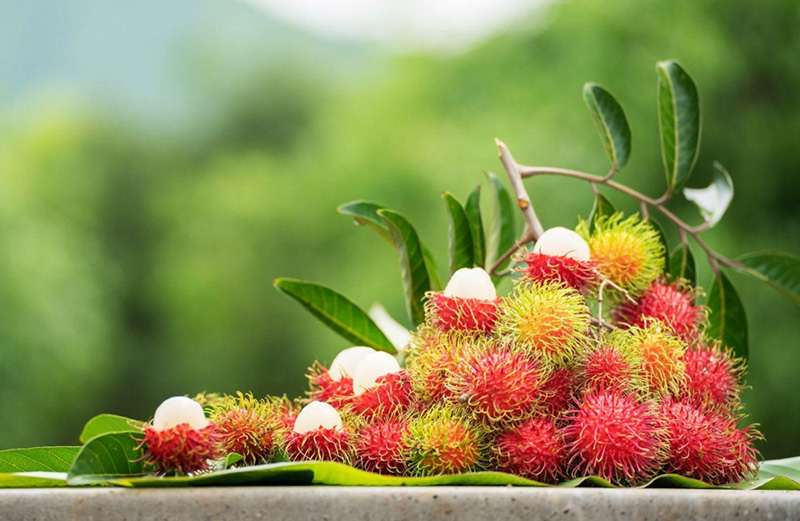
Inside the soft, thin skin is a translucent flesh with a sweet, lychee-like flavour. Twist the fruit in your hands to break the skin, remove the outside and pop the juicy flesh into your mouth. There is a bitter seed in the centre that should be discarded. Rambutans are most abundant from April to September.
Red Jambose | Quả Mận or Quả Roi
Respectively called “Trái mận” in the south and “Quả Roi” in the north of Vietnam, a water apple is bell-shaped, tastes crisp, juicy and fresh and if we were to compare it to any other fruit… well, it’s somewhere between a pear and a melon, with a hint of rosewater thrown into the mix.
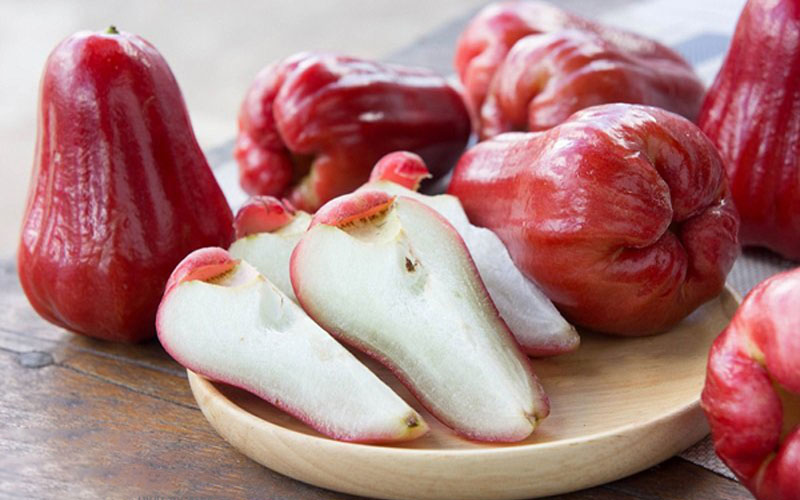
You’ll find the colours range from pale green to dark pink, and the intensity of flavour changes too – the simpler ones are great dipped in chilli salt, but others are very sweet and some deliciously tart.
Passion fruit | Chanh Leo

This purple fruit is one of the tastiest not only in Vietnam, but in Southeast Asia in general. You can eat it raw as a snack or you can use it in all kinds of dishes, as the Vietnamese do. It is delicious with coconut yoghurt and very refreshing as a juice or smoothie, thanks to its unique flavour. Open it with your hands, take a spoon and dig in.
Sapote | Hồng xiêm
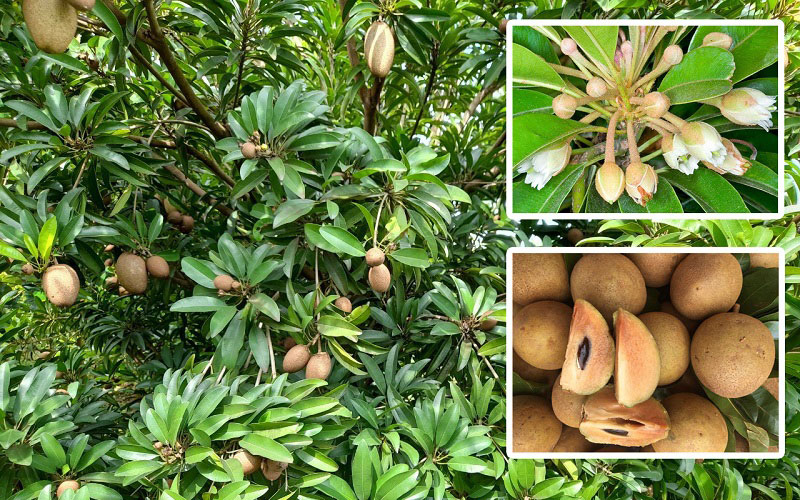
This Vietnamese fruit looks a bit like a small egg-shaped mango, but tastes like a mixture of peach, apple and banana with a sweet touch. It is also one of the fruits that you almost never see in Western countries. However, in Vietnam it is available all year round and is grown mainly in the northern part of the country. Don’t worry, you can also find it in the south. Cut it in half, slice it and share it with a friend.
Durian | Sầu Riêng
Have you ever heard jokes or read stories on the internet about a fruit that is banned from schools, hotels and public transport? While this may seem surreal to Westerners, it is as real as it gets in some Asian countries. In Vietnam it is banned in a few selected places, but less so than in Thailand, so don’t worry. It will be clear from any sign in your hotel or transport whether durian is allowed or not.

You see, the durian has something unique about it. The most fascinating thing is that different people smell it differently. It can range from smells related to various unmentionable bodily functions, to a smell of strong cheese, chives and even spring onions. But don’t let that put you off…
In Vietnam, you can find it any time between May and September. The most common thing you will hear is that “it smells like hell, but tastes like heaven”. It has also been named the king of fruits, so even if its smell is unpleasant to you, try to get over it and eat it. At least once. A very special creamy treat awaits you, and you’ll thank yourself later, honestly!
Guava | Ổi
Guava is one of the most common Vietnamese fruits. Its taste is something between apples and pears, but the fruit is not very tasty, which is probably why Vietnamese people often eat it with chilli salt.
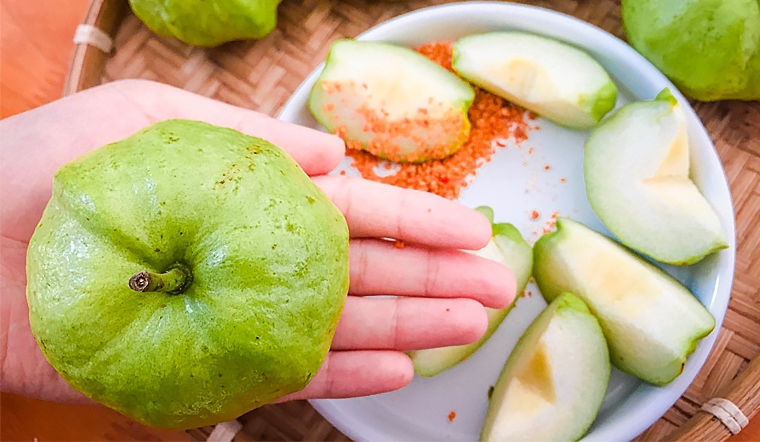
If you haven’t tried eating fruit with a unique seasoning on top, you should not only give each bite a kick, but also bring out the flavour of the fruit. Guava is available all year round in Vietnam and delicious at any time of the day.
Star apple or milk apple | Vú Sữa
Star apples work miracles and their Vietnamese name “vú sữa” literally translates to “mother’s milk”. Whether purple or brownish-green in colour, wait until they are a little soft before cutting them in half and prepare a spoon.
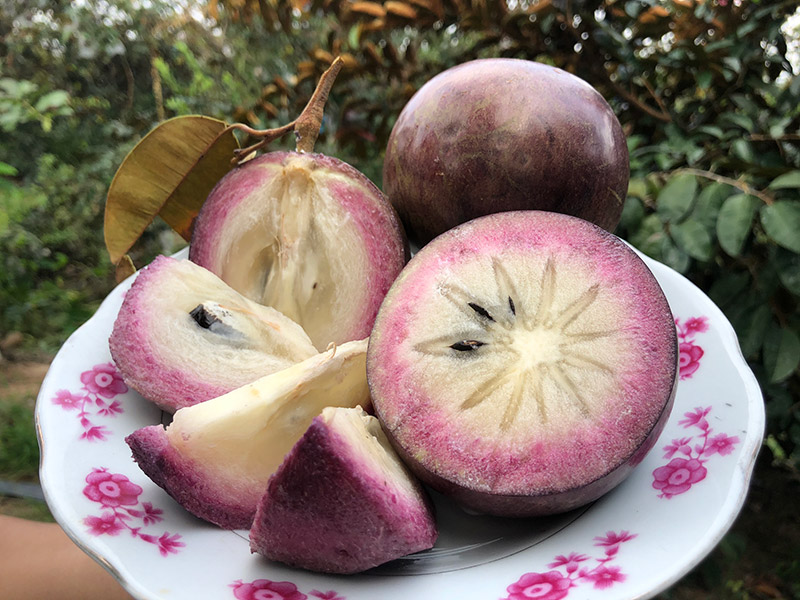
Given their apple-like appearance, what’s inside is a glorious surprise. When fully ripe, the inner flesh looks like firm yoghurt and the consistency is the same. Dip in with your spoon and enjoy all that creamy goodness!
Annona squamosa | Quả na
The cinnamon apple or sugar apple, called “Na” in northern Vietnam and “Mãng Cầu Xiêm” in southern Vietnam is delicious and very nutritious, perfect for eating every day. This fruit has a pale green skin with large bumps. It is heart-shaped, with soft white flesh and large shiny black seeds.

If you plan to eat it that day, buy a soft one without dark spots. A cinnamon apple is ripe when you squeeze it gently and it yields slightly under your hand. Otherwise, take one that still has a hard skin and let it ripen in the days after you buy it. The taste is sweet and the fruit makes an excellent snack. As the name suggests, it tastes like custard.
Mango | Xoài

The mango is mainly cultivated in the southern provinces. There are several types such as Xoai Cat, Xoai Xiem, Xoai Tuong. But the Hoa Loc mango is the most famous one in the Mekong Delta because of its sweet taste and aroma. Above all, it is very good for health and brain development. Mango in Vietnam can be eaten even when it is not ripe. Many people like to eat “green mango” with chilli salt.
Pomelo | Bưởi
Pomelo or grapefruit – Buoi is one of the most popular Vietnamese fruits. There are many kinds of pomelo that are regionally famous for their taste. For example, the green-skinned pomelo in Ben Tre province, the Phuc Trach pomelo in Ha Tinh province or the Doan Hung pomelo in Phu Tho province.

It is full of vitamins, minerals, calcium and protein. Its flavour not only helps you to feel fresh, but also to lose weight. Most importantly, from a pomelo, locals make a wonderful grapefruit tea that visitors will never forget.
Litchi | Quả vải
Lychee is one of the Vietnamese fruits that are well loved by many people. It is abundant especially in early summer. The skin is dark red and easy to peel by hand. The juicy and sweet white flesh contains a lot of vitamin C. It can be served raw or made into a cool drink by adding sugar syrup with other fruits such as mango or dragon fruit.

Lychees from Luc Ngan region, Bac Giang province in the northeast of Hanoi, have gained popularity not only throughout the country, but have also been exported to many foreign markets.
Longane | Nhãn lồng
Longans (nhãn, nhan) grow in drooping clusters. The fruit is globose, 1/2 to 1 inch in diameter, with a thin, brittle, yellow-brown to light reddish-brown rind. The flesh is whitish, translucent, somewhat musky, and sweet. The seed is round, jet black, shiny, giving it the appearance of an eye. This is why longans are also known as “Long Nhãn” (dragon’s eye in Vietnamese).
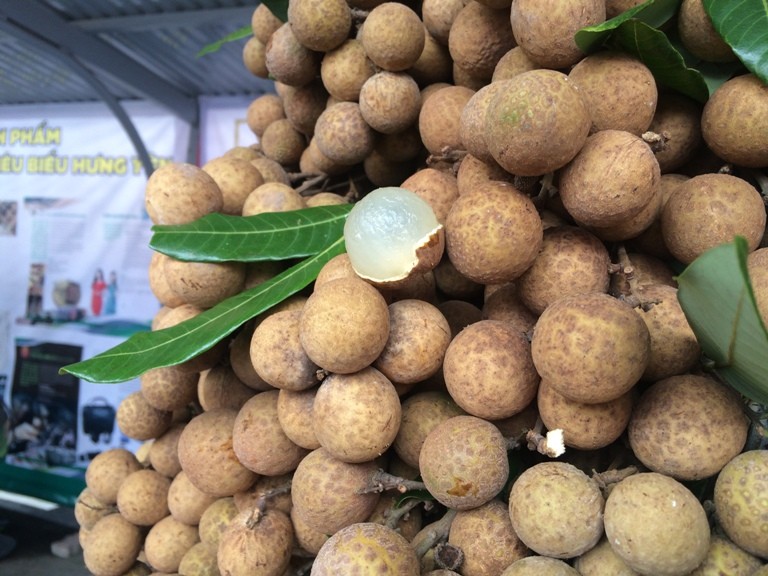
Originating in China and later spreading throughout the world, it is now widely cultivated in Thailand, India and several other Southeast Asian countries, including Vietnam. Longan is available in abundance in summer and can be eaten both raw and as dried fruit.
Jackfruit | Mít
The jackfruit, one of the popular Vietnamese fruits, may remind you of the durian with its ruffled skin and large shape. However, its sweet taste and amazing smell often attract gourmets. Inside, there are many fleshy yellow nodes covering all the seeds of the fruit when peeled.

However, its latex is sticky, so remember to use a towel or glove to separate the outside of the fruit and remove any knots. In addition, jackfruit trees are also full of many types of health nutrition. If you want to enjoy tropical fruits in Vietnam, it is better not to miss this fruit.
FAQ
What is the national fruit of Vietnam?
The dragon fruit, known locally as “Thanh Long”, is considered the national fruit of Vietnam. There are two versions of the fruit and if the local people you buy it from don’t speak English, it will be a surprise if the inside is a light white or a juicy pink. However, roses usually have a darker skin. Either way, the fruit is absolutely delicious and once you’ve tasted it, you’ll want more.
How do you say “fruit” in Vietnamese?
Next time you go to the local market or supermarket, make sure you write “trái cây” if what you are looking for is fresh fruit.
Can you eat fruit in Vietnam?
Not only can you eat fruit in Vietnam, you should definitely do so. Make sure you try as much as you can and have a different fruit every day – it’s not only healthy, but discovering brand new flavours is a really rewarding experience!
The only rule you need to follow is to wash it well before eating it, as you should always do, no matter what country you’re in.
Photos : Internet

